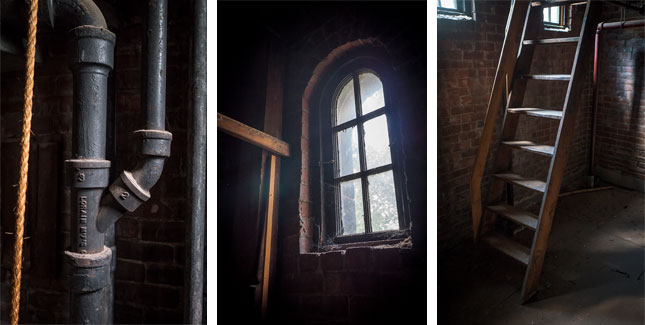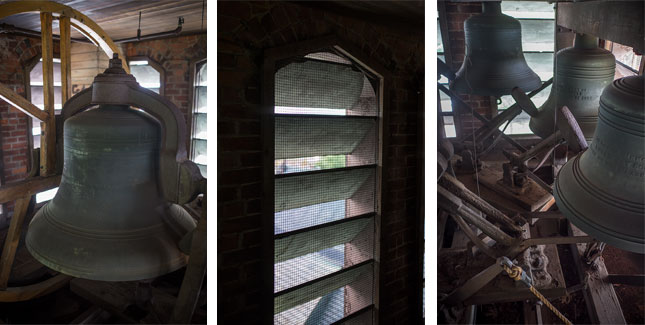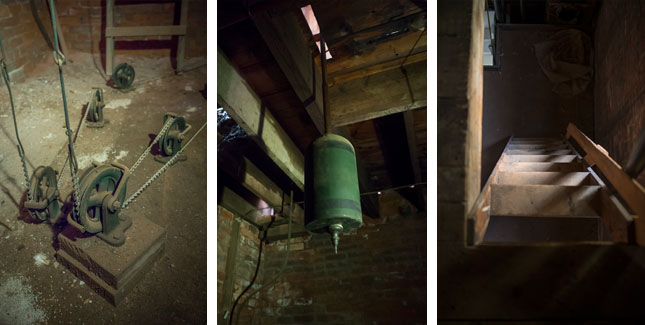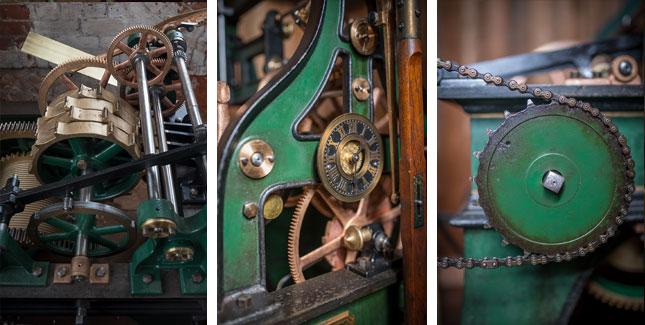A Tour Inside the Iconic Campus Clock Tower
On the third floor of Mary Lyon Hall, down a hallway and through two offices, if you look up and behind a door, you will see in the ceiling a small trap door.
Under it stands a ladder, next to which hangs a thick tan rope. From this rope, the bell in the clock tower—a sound iconic to the Mount Holyoke community—may be manually rung to announce significant events, including, famously, Mountain Day.
But there are five more levels—and an elaborate system of machinery—above the end of this rope. Each is approximately twelve feet square with stone walls at least a foot thick and is accessible only by climbing a series of wooden ladders through small openings in the floors. The air is full of dust, and cobwebs cover walls and surfaces.
The first level is empty but for some pipes against one wall. Three small arched windows in the west-facing brick wall let in light. Another ladder is propped in the corner of the room opposite the trap door opening.
At the top of the ladder is an old disused metal radiator, originally installed to keep water tanks housed there from freezing in the winter. Relics from a bygone time, the tanks were once kept full to supply an archaic sprinkler system.
Another ladder, dirty with brick-colored dust, leads to the bells. In the center of the room the largest of four bronze bells is perched within an enormous metal frame. On one of its massive greening sides, letters spell out Meneely Bell Company/ Troy, N. Y., U. S. A./ A. D. 1897, the year the hall was built.
The bell is so thick one can barely grasp the entire edge underneath in one hand. The clapper alone is the size of a softball. Three smaller bells—though smaller in this case still means three feet tall—are suspended by a wooden beam along the southeast corner of the room. They were given by the class of 1900, and each is emblazoned with the words In loving memory of Annah May Soule, a Mount Holyoke professor of American history and political economy.
Except for special occasions, the bells ring automatically to mark the time; the big bell sounds on the hour—one ring for each hour—and the trio of bells chimes musically each quarter hour. A hammer on a lever clangs upward inside the large bell; similar hammers are positioned to tap downward onto the outsides of the smaller bells. Once performed with a series of weights, much of the tolling is now conducted by electrified machinery.
Each brick wall has three floor-to-ceiling openings partly covered by external metal shutters and internal screening, which let in air and let out the pealing of the bells while keeping birds and bats from entering.
In the ceiling of the fourth level, visible only by flashlight, the deep green and black pendulum of the clock swings heavily back and forth. One can only guess how heavy it must be, but its ticking is surprisingly soft.
At the fifth and final level, the last trap door swings open to a bright space. In each of the four walls is a translucent clock face five feet in diameter, ringed in black Roman numerals. Metal bars connected to the centers of each clock face control the hands on the opposite sides from within a wooden closet in the middle of the room, in which the main clock machinery is housed.
On a brass plaque affixed to the side of the green, gold, and black painted frame, the manufacturer is named as Seth Thomas Clock Co., Thomaston, Conn. U.S.A. Under it, the installation date is engraved as well: July 2, 1897. Dozens of shiny copper-colored cogs turn parts within this and two other machines outside the closet, which synchronize the bells. The clock had a thorough repair and cleaning last fall due to wear, as most parts are original.
Hundreds of names and dates spanning back to the 1970s have been scrawled in pencil on the outside of the door of the closet, the markers of visitors. Four regular-sized light bulbs are set into each side opposite the clock faces in diamond shape patterns. In addition to the three smaller bells, the class of 1900 donated money for the illumination, though records indicate that the actual lighting wasn’t installed until 1936.
A place rarely visited and largely outfitted with original parts, the clock tower has held people captive since its construction. And it is thanks to a system of countless pulleys, chains, levers, pipes, and wires that a lovely peal announces each fall that Mountain Day has, once again, arrived.
—By Anne Pinkerton
—Photos by James Gehrt
A similar article appeared as “Inside the Clock Tower” in the fall 2017 issue of the Alumnae Quarterly.
Watch a video of the bell being rung for Mountain Day.
October 13, 2017











What a wonderful and amazing article! The photographs are superb and made me feel I was right there inside the clock tower experiencing the intricacies of its mysteries first hand. I can imagine what a committed team of technicians must be required to keep all those beautiful antique clock parts humming in such unison. Thank you for such an interesting, informative article.
I’ve always wanted to know what the inside of the tower looks like. I lived in Pearson’s Hall ‘81-‘83 & loved looking at the clock tower & hearing the bells. Thank you to the people who keep it in working order. It’s such a wonderful piece of the MHC experience. Great article!
Delightful! A very nicely done tour of a place so central to the MHC campus. Fond memories of Mountain Day, too.
I, too, lived in Brigham, second floor, as a MHC freshman in 1948-49. The bell sounds are forever in my memory!
I love those bells and the clock. Thank you for the article, video, and thank you to the people who take care of the bells and clock. I was in Safford Hall freshman year and the bells were welcome friends. They sound “right” to me and very few other bells do. They sounded just as wonderful at our 50th reunion.
It is the “Meneely Bell Foundry” of “Troy N.Y.” – the company has a very long history dating to the early years of the 19th century and has been operated under different partnerships and used several different names over the decades
Many thanks, Dennis, for reading and catching this. We will correct it.
I lived on the second floor of Brigham Hall in 1989-90. I had just arrived at MHC as a transfer student, and could hardly believe my good luck in landing at such an amazing college. Now I live in California, just down the street from a church with a bell tower, and the pealing of its bells always makes me smile with good MHC memories.
Thank you for sharing the backstory behind the wonderful tradition of Mountain Day. It’s great to learn a little more about the people who help make it happen and keep the tradition alive.
So interesting to see the bell up close! I have very fond memories of the bell, as my freshman year I lived in the closest room on campus to the clock tower: the fourth floor corner room in Brigham. The bell tolling on Mountain Day was the sweetest sound ever! Oh, the memories…
Many thanks for the article.